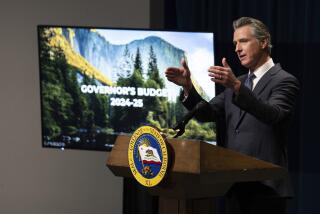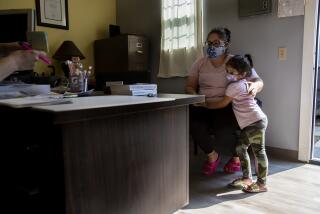Jobless Aid Fails to Keep Up With Employment Changes : Society: Except for a few shining examples, the aging system isn’t providing the help displaced workers need.
TAMPA, Fla. — Ruth LaHue tells the sort of success story government policy planners dream about.
Laid off in early February from her secretary’s job, the 47-year-old mother of three visited an innovative unemployment benefits office here and spoke with a job counselor familiar with state and federal programs for displaced workers. The counselor took her to another office for a skills test and a review of possible career goals.
Now LaHue has made plans to return to college to fulfill a long-held dream of becoming a special education teacher--honing talents learned through caring for a 15-year-old son who is deaf.
“I felt really devastated when I lost my job,” she says, “but that doesn’t mean something really good couldn’t come out of it.”
Usually, however, it doesn’t.
Despite isolated examples such as the employment center that helped LaHue, the nation’s unemployment system--a 59-year-old patchwork of programs established by the New Deal as a key part of the nation’s social safety net--is badly out of date and failing to provide the help displaced workers need.
The reason: The nature of unemployment in America has changed but the unemployment system has remained the same.
Tampa’s setup, where state officials have consolidated in one building a range of programs to aid displaced workers, is the exception. In many parts of the country the local unemployment office, where people apply for benefits, and the employment service, which is supposed to help people find new jobs, are not even located in the same part of town. Existing federal programs are widely scattered and often poorly coordinated with state and local efforts.
Federal programs to aid dislocated workers manage to provide some level of assistance to roughly half a million people a year, but under widely varying and often bewildering rules and regulations. One program aids workers who have lost jobs because of import competition, another exists to help workers whose jobs have suffered because of clean air rules, still another benefits the small number of workers displaced by Redwood National Park in Northern California.
When a Pennsylvania plant that made paper goods closed recently, workers who had made paper napkins there were deemed eligible for federal aid on the grounds of import competition. Those who had made paper cups were out of luck.
The problems of the unemployment system seemed more critical a year ago, when many economists believed that the country faced a “jobless recovery” in which even economic growth would not bring back robust employment figures.
Today that fear has faded. Nationally, the unemployment rate has dropped steadily and, even in hard-hit Southern California, employment is beginning to show some signs of recovery. By 1997, the majority of government and private economists forecast, the United States will once again have reached the “full employment” level--the term economists use to designate the lowest level that unemployment can reach without sparking inflation.
But even at the full-employment level, more than 6.5 million Americans will remain looking for work and millions more will be stuck in part-time or temporary jobs when they would prefer full-time work.
With those figures in mind, President Clinton and Labor Secretary Robert B. Reich have made fixing the shortcomings of the U.S. unemployment system a priority. Earlier this month, Clinton unveiled legislation to improve the system--an initiative that has been Reich’s top priority for this year.
Even with the recession over and unemployment rates dropping, Reich says, what he calls a “re-employment” system would address an important public concern. “Many people are scratching their heads and saying, ‘Wait a minute. The economy is getting better, jobs are coming back, so why do I feel so insecure?’ ”
Part of the answer, Reich argues, is the belief many workers share that if they lose their job, they will have neither the skills to find new work nor any government program capable of helping.
“In a democratic society, there really are only two alternatives,” he says. “Either people hold on to what they have--they seek regulations, they seek protectionist barriers to imports, they don’t want to allow immigrants into the country, they sort of hunker down--or they find easy passageways to new jobs and better alternatives.”
If the country wants to keep the open and flexible labor markets that have been a major contributor to U.S. prosperity--and a major reason that the United States has avoided the economic problems now plaguing Western Europe--then “we all have a stake in making sure people can move to new and better jobs quickly.”
Research on experimental state programs scattered across the country over the last decade indicates that well-designed government programs can significantly ease the transition from one job to the next. But so far no one is trying to expand those scattered initiatives into a national system.
The goal of most of the successful programs is to reduce what economists refer to as “frictions” in the labor market. Workers who lose their jobs have little sense of what employment alternatives exist and what skills they need to find a new job.
Unemployment insurance, the chief government program to help those out of work, is a largely passive system designed to keep workers from falling into poverty during layoffs. But in most parts of the country, the system does little to provide the sort of information unemployed workers need to find a new job or to help them improve their job skills.
The Administration’s proposed solution would require all states to screen workers as soon as they apply for unemployment benefits in order to identify quickly those at risk of long-term unemployment. Those workers would then automatically receive specific help in finding a job--computer listings of job openings, for example--when they receive their unemployment insurance.
In tests in states such as New Jersey, unemployed workers who were given help with job searches found jobs faster than those left on their own. The state saved more money in unemployment benefits for the assisted workers than the assistance cost.
In addition to job search assistance, many dislocated workers under the Administration’s proposal would receive counseling and skills testing, much as LaHue did, and a smaller number would receive federally supported job training. The new training program, although sharply limited to conserve scarce federal dollars, would still roughly double the number of workers eligible for help from about 250,000 a year now to some 500,000 by the end of the decade.
The problems the Administration hopes to address have been increasingly obvious for two decades. Beginning in the late 1960s and early 1970s, an explosive mixture of forces combined to vastly expand the supply of workers while hurting demand for them, particularly for low-skilled workers.
Among the forces were the influx of the baby boom generation and large numbers of women into the job market, the increase in international trade, changes in technology and the declining power of unions. The results were a sharp increase in unemployment levels, reduced job prospects for people who lost their work and declining wages for those with few job skills to sell.
Through the 1950s and 1960s, national unemployment rates would rise in recessions to roughly 6% then fall back in good times to less than 4%. Beginning with the early 1970s, unemployment rates have never dropped below 5% even in good times and have often risen well above 7%.
More notably, the percentage of the unemployed who are out of a job for more than six months has risen from roughly 11% during the 1960s and 1970s to more than 15% during the 1980s and so far in the 1990s.
Increased, as well, is the percentage of people who lose their jobs permanently as opposed to those for whom unemployment means only a temporary layoff. The Labor Department calculates that in the last recession, only 14% of the unemployed were on temporary layoff, as opposed to an average of 44% during the previous four recessions.
A study by the Congressional Budget Office last year calculated that each year through the 1980s, whether the economy was growing or not, nearly 2 million Americans were permanently displaced from their jobs.
While most eventually found new jobs, many were unemployed for months, and nearly one-third eventually had to take jobs earning 20% or more below what they had been earning.
Given the continued pace of corporate layoffs and defense cutbacks, both the CBO and the Administration estimate that the number of displaced workers will continue in the range of 2 million a year for the rest of the decade.
A system that helps workers find new jobs more quickly and provides training to those most badly in need of new skills could make a small but significant dent in those numbers, argues Administration economist Alan Blinder, a member of the Council of Economic Advisers whom Clinton plans to appoint to the Federal Reserve Board.
“One wants to make modest claims for these things,” Blinder says, but each of the Administration’s “human resources” programs--improvements in education, school-to-work programs to help non-college-bound graduates get their first job, welfare-to-work programs and programs for unemployed workers “all push in the same direction” of improving the skills of the labor force and easing transitions from one job to the next.
No one element of the program will completely reverse the long-term increase in the non-inflationary unemployment rate, Blinder said. But, he noted, even a 0.1% drop in the unemployment rate means another 125,000 jobs.
“A realist would say there are limits to what government can do,” Blinder said. “A pragmatist will say the government should do what it can.”
More to Read
Get the L.A. Times Politics newsletter
Deeply reported insights into legislation, politics and policy from Sacramento, Washington and beyond. In your inbox three times per week.
You may occasionally receive promotional content from the Los Angeles Times.











